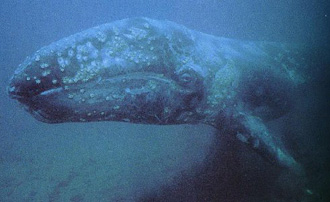 |
 |
 |
 Editorials | Environmental | July 2007 Editorials | Environmental | July 2007  
Scientists Say Warm Water May Cause Skinny Whales
 Kenneth R. Weiss - Los Angeles Times Kenneth R. Weiss - Los Angeles Times
go to original


| | Scientists from Mexico to the Pacific Northwest are reporting an unusually high number of scrawny whales this year for the first time since malnourishment and disease claimed one-third of the gray whale population in 1999 and 2000. |
San Simeon, Calif. A female gray whale labored up the coast, the bony ridge of a shoulder blade protruding from what should be the smooth, plump roundness of healthy blubber.

"That female looks a little skinny," said federal biologist Wayne Perryman. "You can see her scapula sticking out. Yeah, she's a skinny girl."

Scientists from Mexico to the Pacific Northwest are reporting an unusually high number of scrawny whales this year for the first time since malnourishment and disease claimed one-third of the gray whale population in 1999 and 2000.

So far, scientists have seen no decline in numbers this year, and they are not sure what's causing the whales to be so thin. But they suspect it might be the same thing that triggered the die-off eight years ago: rapid warming of Arctic waters.

Whales depend on cocktail-shrimp-size crustaceans to bulk up for their long southerly migration. As Arctic ice recedes, fat-rich crustaceans that flourished on the Bering Sea floor are becoming scarce.

Skinny whales were first spotted this year in the protected waters of San Ignacio Lagoon in Baja California, where gray whales spend the winter breeding and nursing calves before returning every summer to the Arctic.

That's where a team led by Steven Swartz of the National Marine Fisheries Service in Silver Spring, Md., and Jorge Urban of the Autonomous University of Baja California Sur noticed about 10 percent looked more bony than blubbery, a telltale sign of malnutrition.

Seeking out food

Instead of making steady progress during their migrations, whales have been stopping often to eat along the way.

They have been seen straining mysid shrimp from kelp beds off California and British Columbia, sucking up mouthfuls of sand in Santa Barbara Harbor and skimming surface waters for krill-like crustaceans all along the West Coast.

Such opportunistic feeding has its risks. Switching to new food can expose the whales to harmful parasites and other hazards. There have been at least two fatal accidents this spring near San Francisco's Golden Gate Bridge. Gray whales surfacing to breathe have been ripped apart by propellers on cargo vessels.

To find food, some gray whales have been extending their 5,000-mile northerly migration beyond the Bering Strait into seas north of Alaska.

It used to be a rare occurrence to see gray whales off Barrow, Alaska, said Craig George, a North Slope Borough wildlife biologist since the 1970s. In recent years they have become summertime regulars, churning up mud plumes along the shoreline in search of food.

Their arrival has become an annoyance and even a navigational hazard for local Inupiat (Eskimo) subsistence hunters, who have permits to hunt bowhead whales but not grays.

"During fall bowhead whale hunting season, they see a blow and divert off course only to find it's a gray whale," George said.

Historically, the eastern Pacific gray whales congregated every summer in the shallows of the Chirikov Basin, a place in the north Bering Sea known for vast sea-floor carpets of crustaceans called amphipods.

"You could practically walk across the gray whales in the Chirikov Basin in the 1980s," said Sue Moore, a former director of the National Marine Mammal Laboratory in Seattle who has conducted aerial surveys. "They were stacked up to the horizon. In 2002, I went back and everything had changed."

The carpets of crustaceans were frayed and, in some places, gone.

Scientists first thought the gray whale population had simply grown too large for its primary food source and eaten more than nature could provide. Such overgrazing was thought to have been responsible for the mass die-off in 1999 and 2000 that saw the population drop from 26,600 to about 17,400.

Now scientists suspect climatic changes in the Bering Sea played a role in the population plunge by reducing the whale's primary food: amphipods apparently affected by warming temperatures and vanishing ice.

Fewer calves?

Federal scientists believe the gray whale population is holding steady at 18,000, though they are working on a new estimate.

The population grew steadily until 1998, the year of a warm El Niño now seen as a turning point for Bering Sea amphipod beds. The annual tally of calves has fluctuated since. This year's was one of the lowest since the federal government began keeping track in 1994.

"The gray whales don't seem as robust as they once were," said Perryman, a National Marine Fisheries Service scientist in charge of the annual count of gray whale cows and calves.

He and his crew keep watch 12 hours a day from March to June tallying each gray whale that passes by the Piedras Blancas Lighthouse near San Simeon's Hearst Castle on California's Central Coast.

Perryman believes the number of calves plunges when whales do not get enough to eat.

The loss of Bering Sea feeding grounds is responsible for another trend: More whales don't bother heading that far north. Some stop at Alaska's Kodiak Island. Others don't get even that far and spend summers near British Columbia's Vancouver Island or off the Oregon coast. Smaller groups remain off California, feeding on shrimp in kelp beds or anything else they can scrounge.

"These animals are feeding on things that scientists haven't observed in modern times," said Bruce Mate, director of the Marine Mammal Institute at Oregon State University. "They are beginning to become more diverse in their diet because they have to." | 
 | |
 |



